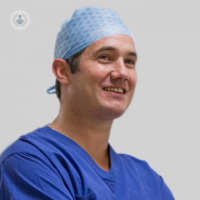Ligamentoplasty
Mr Andrew Davies - Orthopaedic surgery
Created on: 04-18-2016
Updated on: 01-12-2024
Edited by: Karolyn Judge
What is ligament reconstruction?
Ligament reconstruction, also known as ligamentoplasty, is an endoscopic procedure for surgical tissue graft replacement of the anterior cruciate ligament, a ligament in the knee, often by grafting tissue harvested from your own body.
Ensuring your knee is stabilised again
The anterior cruciate ligament is located in the central part of your knee and it stabilises the knee joint. Ligomentoplasty surgery will ensure that your knee is stabilised again, avoiding potential damages which could affect the cartilage and meniscus.
Why is a ligamentoplasty performed?
Ligamentoplasty is sometimes performed if you have suffered from a strong enough joint trauma that the ligament has torn in your knee. When your ligament is torn, you will feel severe pain and your knee will be swollen. There may also be fluid regurgitation within the knee.
What conditions can cause a ligamentoplasty?
Trauma can be the consequence of injuries, including:
- a sprain, or;
- a sudden inward rotation of the knee after falling down, or;
- overextending your knee.
What does the ligamentoplasty procedure involve?
The surgery consists in harvesting and then grafting a ligament from your own body.
First phase of ligamentoplasty
The first phase of the procedure consists in harvesting a healthy ligament, which will substitute the ruptured ligament. The most commonly harvested ligaments are the knee flexor tendon, patellar tendon and hamstring tendon. Using synthetic materials is only recommended if your rupture your ligaments again.
Surgery should not last more than 45 minutes and it is an arthroscopic procedure – a minimally invasive form of surgery that can also allow the surgeon to address other issues at the same time.
What happens after a ligamentoplasty procedure?
Post-operative hospitalisation does not normally last more than three days.
Harvesting the healthy portion of tendon should not cause any mobility issues. You will be able to move your leg right away, with the use of a knee brace or crutches for the first three weeks.
Based on your doctor’s advice, in the first two weeks after surgery you may need to have injections to avoid the risk of venous thrombosis. After roughly six weeks, you will be able to go back to your daily activities; however, you’ll need to wait before going back to sports.
You should keep in mind that ligaments stabilisation is a slow complex biochemical process: that is why should avoid excessive exertion and straining which could sabotage your healing process, while also doing physical therapy.










